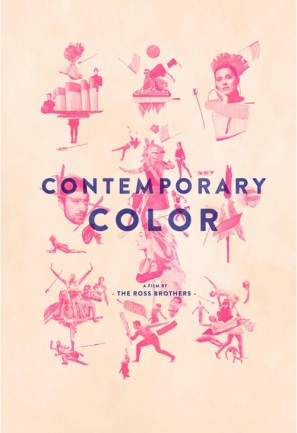Doc Corner: 'Contemporary Color'
 Tuesday, March 7, 2017 at 10:30AM
Tuesday, March 7, 2017 at 10:30AM  Jonathan Demme’s Stop Making Sense is such an extraordinary piece of cinema that it is only natural that it casts a long shadow. That 1984 concert documentary of Talking Heads stuck in my mind a lot while watching Contemporary Color from directors Bill and Turner Ross. Not just because both films feature David Byrne as the primary artistic force behind them, but because they each suffuse music with performance with personality with theatricality. They both strive for an almost heightened sense of spirituality out of the creation of art. It’s just a shame that in the case of the Ross brothers' film, it just comes across as sloppy.
Jonathan Demme’s Stop Making Sense is such an extraordinary piece of cinema that it is only natural that it casts a long shadow. That 1984 concert documentary of Talking Heads stuck in my mind a lot while watching Contemporary Color from directors Bill and Turner Ross. Not just because both films feature David Byrne as the primary artistic force behind them, but because they each suffuse music with performance with personality with theatricality. They both strive for an almost heightened sense of spirituality out of the creation of art. It’s just a shame that in the case of the Ross brothers' film, it just comes across as sloppy.
The film documents the performance of a special one-off performance at the Barclay Centre in Brooklyn. Spearheaded by Byrne and his newfound obsession with color guarding – a sort of synchronised swimming, but on land, and with way more prop rifles; Byrne describes them as “sophisticated folk art” – the event finds him inviting ten color guard teams and have them perform for a stadium audience alongside musical guests who wrote original songs as soundtracks. Songs, it must be said, that mostly sound like discarded album tracks and demos lifted out of storage and dusted off like it’s Woody Allen’s Irrational Man screenplay.
Some of the musicians like St. Vincent and Devonté Hynes (a wonderful discovery for myself) and even the hipster nonsense of a band ridiculously named How to Dress Well feel like naturals. Others like Nelly Furtado, Lucius, and Zola Jesus do not. Collaborating together, Ira Glass and Nico Muhly come closest to bridging the two worlds of music and dance performance best of all with a narrated soundscape featuring audio excerpts from Glass’ interviews with the dancers.

Beyond this sequence, the stories behind the color guarders, what brought them to the sport and what brought them to the Barclays Centre, are more or less unexplored in any effective detail. Efforts made by an awkward backstage emcee (of sorts – it’s hard to really tell what he’s meant to be) to get the dancers to divulge their inspirations frequently turn into hyperventilating giddiness. It’s cute in the moment, and offers in its own way a form of insight into these men and women, but for a documentary that’s already threadbare, it becomes a bit of a crutch to excuse digging deeper. You can see how excited they are so why does anything else matter?!
Most frustrating of all, however, and the reason why I ultimately don’t believe the film succeeds, is that the filmmakers never truly find a coherent way to visually reconcile both the music and the dance. Three cinematographers are listed, but the cameras rarely offer up anything beyond the standard long-medium-close set-ups while Bill Ross’ editing is often choppy, focusing too often on the musicians on stage and not the dancers below. Baffling choices are made throughout, like how the natural rhythms of the music and the narratives of the choreography are frequently broken up by unnecessary cuts from the floor to the backstage to other performers getting ready or just, for some unknown reason, empty corridors. At one point, we leave the action on stage to watch the stadium’s maintenance staff attending to a water spill. It is not thrilling. There is also no context to be found for a brief cut away to the breaking news of SCOTUS’ decision on same-sex marriage beyond perhaps a flaccid concept of togetherness.

Only occasionally does the full potential of the endeavour as a cinematic experience – I am sure being at the event itself was a pure delight – truly come across. St Vincent’s number, for instance, allows the screen to become awash in color and movement as images are transposed over one another. It’s ethereal and rather beautiful and a sign of what could have been with a stronger cinematic concept. Contemporary Color doesn’t need to be compared to Stop Making Sense to disappoint, but boy is it hard to not.



Reader Comments (2)
I saw this at the Sydney Film Festival last summer and could not understand the praise it was receiving at the time. I was in marching band during high school so I was excited for a film that spotlighted color guard. But I agree with you, Glenn, that the film did very little to showcase the guards and instead came off as...something. It's not really an advertisement for the artists either, so I guess it's just a testament to Byrne's ability to put together a show like this in a venue like the Barclays Center? It was the most diappointing film I saw at the festival.
Jason, I am baffled that it has won editing awards considering it appears to completely misunderstand what editing is supposed to do.